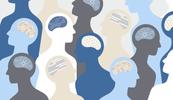How SLPs Can Make an Accurate Aphasia Diagnosis

Speech-language pathologists (SLPs) are central figures in making an accurate aphasia diagnosis and treatment plan. They play a critical role in assessing aphasia—an acquired neurogenic language disorder—and delivering evidence-based therapy to those affected by it.
As integral members of the support system for people with aphasia, SLPs can help guide patients and their families toward improved communication and quality of life in the face of this complex language disorder.
In this article, we will delve into four types of aphasia—expressive aphasia, receptive aphasia, global aphasia, and anomic aphasia—providing examples, causes, and treatments for each.
Causes and symptoms of aphasia
Aphasia occurs as a result of a brain injury, most often to the left hemisphere, where language networks are heavily concentrated. Strokes are a leading cause of aphasia.
People with aphasia may experience impairments in:
- Spoken language expression
- Spoken language comprehension
- Written expression
- Reading comprehension
Not everyone with an aphasia diagnosis has difficulty speaking fluently. Likewise, some individuals with aphasia can easily understand what they hear in conversation—even if they struggle to respond fluently.
Zooming in on different types of aphasia can give us a glimpse into the neural underpinnings of language, and the role SLPs play in rehabilitation.
How to make the correct aphasia diagnosis
No two clients will present with aphasia in the same way. It’s no wonder, given the intricacy of the human brain and its associated language mechanisms.
Still, an aphasia diagnosis can be better understood by examining client symptoms and the parts of the brain affected.
Below, we’ll explore four common types of aphasia and their differing presentations. While this is by no means an exhaustive list of aphasia types, it captures some of the primary categories of this neurogenic language disorder.
However, SLPs should be aware that patients may not fit neatly into one “type” of aphasia—and even when they do, their presentation may evolve over time, making the categorization less representative of their current status.
4 types of aphasia
1. Expressive aphasia
Also known as Broca’s aphasia (due to the region of the brain impacted), or non-fluent aphasia, this disorder is characterized by difficulty forming words and sentences.
People with Broca’s aphasia may perfectly understand what they hear, but struggle to respond coherently. They may also have difficulty repeating what they have heard.
Expressive aphasia causes and examples
Expressive aphasia is caused by damage to Broca’s area, a part of the brain located near the front lobe and typically in the left hemisphere.
This neurogenic language disorder is often the result of a stroke, but can also occur after a traumatic brain injury or in response to a brain tumor.
Broca’s area is a region of the brain that supports speech production and language processing. When it’s damaged, forming words and sentences can become an immense challenge.
People affected by expressive aphasia may feel that the words they seek are on the tip of their tongue, but they can’t find them. Understandably, this causes a great deal of frustration.
As a non-fluent form of aphasia, this type of aphasia diagnosis is characterized by:
- Difficulty with production of spoken language (words and sentences)
- Inconsistent (or nonexistent) grammar
- Trouble repeating words or sentences
- Omission of grammatical forms like articles (e.g., “a” and “the”) or conjunctions (like “and”)
- Difficulty reading and writing
Some clients with Broca’s aphasia may repeat the same words or phrases over and over—even if they are unable to repeat what others say to them. In severe cases, individuals affected may not be able to make any sounds.
It’s critical to recognize that those with expressive aphasia can understand what they hear, even if they cannot respond, since comprehension remains largely intact.
2. Receptive aphasia
Conversely, someone with the receptive type of aphasia—sometimes called Wernicke’s aphasia or fluent aphasia—can form words and sentences without difficulty, even if their language is not coherent.
While spoken language production remains intact, comprehension is greatly impacted. People with this form of aphasia may have a great deal of difficulty understanding what they hear, especially as sentences and conversations increase in complexity.
3. Global aphasia
Just as its name implies, the global type of aphasia affects all language, and multiple regions across the brain. As such, it is the most severe form of aphasia.
Physically forming words is a challenge for people with this type of aphasia. At the same time, language comprehension is impaired. Major strokes and head injuries are linked to this type of aphasia, since many areas of the brain are impacted.
4. Anomic aphasia
This type of aphasia is characterized by anomia, or difficulty with word retrieval.
People impacted by the anomic variety of aphasia may spend a long time searching for the right words, exhibit circumlocution (talking around the target word), or use more general vocabulary (e.g., “stuff”) in place of precise language.
Aphasia vs dysphasia vs dysphagia
Dysphasia and aphasia are often used interchangeably. This can lead to some confusion about an aphasia diagnosis.
Put simply, dysphasia is another term to describe impairment of language production or comprehension after damage to the brain. Dysphasia (ending in sia) should not be confused with dysphagia (ending in gia), a relevant and widely used term among SLPs to describe swallowing disorders that affect speech.
Dysphasia is sometimes used to describe moderate, or partial, language impairment, while aphasia could be used to describe a more severe condition. However, aphasia has become the preferred terminology for this acquired neurogenic language disorder—regardless of its severity.
Additionally, an aphasia diagnosis can occur alongside dysphagia. For example, after a stroke or traumatic brain injury a client may experience issues with a slackened jaw or facial drooping that affects swallowing and speech.
It’s essential to clearly delineate these three (often confusing) terms to patients, caregivers, and other members of the healthcare team to ensure everyone is on the same page.
Is aphasia permanent?
When an aphasia diagnosis presents itself, many questions arise from patients and caregivers. One of the most common among them is: Is aphasia permanent?
SLPs know that the answer is nuanced.
Neuroplasticity means that recovery of language skills after the onset of aphasia is possible. However, the level of recovery that is possible will depend on a variety of factors. For example, the cause of the aphasia, how quickly that cause was treated, and the extent that speech therapy was provided—especially in the initial months after the aphasia diagnosis.
If aphasia is the result of a temporary condition—like a concussion, seizure, or infection—the aphasia itself may also be temporary. However, after a severe stroke or traumatic brain injury, significant rehabilitation may be needed to support the brain’s healing. Full restoration of language capabilities isn’t always possible, but clients can still make progress and learn coping strategies.
That’s where speech therapy comes into play. SLPs can facilitate the right type of intervention from the outset, giving clients and caregivers the tools to communicate with greater ease.
Aphasia treatment
There’s an ever-growing body of evidence-based aphasia treatment options available for SLPs to implement.
Therapy approaches may focus on life participation, person- and family-centered care, and the functional impact of aphasia. They should also take into account social, cultural, and linguistic factors that tie into the patient’s communication style and needs.
Therapy can be both restorative and compensatory in nature.
Expressive aphasia treatment comes in a variety of forms. Some of the most common methods include:
- Verb Network Strengthening Treatment (VNeST): Focuses on verbs and activation of the semantic networks that strengthen underlying syntactic structures like subject-verb-object.
- Semantic Feature Analysis: Activates semantic features related to target words, rebuilding a client’s vocabulary by developing connections between concepts across a variety of categories.
- Melodic Intonation Therapy: Engages the brain’s right hemisphere by harnessing the power of pitch, stress, and rhythm in producing phrases—especially those significant to the client personally and functionally.
- Augmentative and Alternative Communication (AAC): By using low-tech AAC, like communication books, or high-tech AAC, like an electronic device, individuals with aphasia can supplement or compensate for spoken language.
There is no single treatment approach that works best for all forms and presentations of aphasia. SLPs may provide multiple types of intervention—focusing on speaking, listening comprehension, reading, or writing.
Researchers continue to explore new methods of aphasia treatment, ensuring SLPs can support clients in rebuilding their communication capacities to the greatest extent possible.
How SimplePractices streamlines running your practice
SimplePractice is HIPAA-compliant practice management software with everything you need to run your practice built into the platform—from booking and scheduling to insurance and client billing.
If you’ve been considering switching to an EHR system, SimplePractice empowers you to run a fully paperless practice—so you get more time for the things that matter most to you.
Try SimplePractice free for 30 days. No credit card required.
More Stories
Stay inspired
Get the latest stories from your peers right to your inbox.










